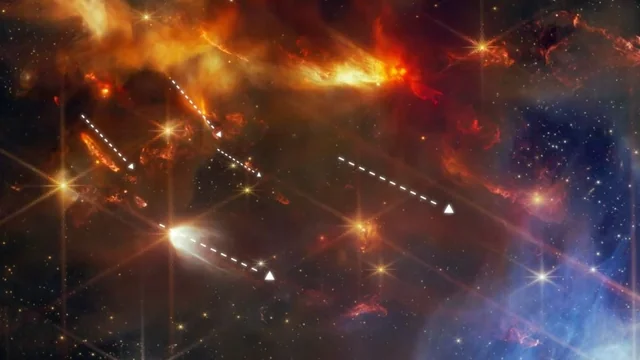Mysterious Parallel Jets of Light

Astronomers using the James Webb Space Telescope (JWST) have observed a new stellar phenomenon: a group of baby stars emitting high-speed gas jets in the same direction.
This discovery provides the first direct image of protostellar outflows—huge jets of gas from newborn stars that interact with surrounding molecular gas clouds. However, it also introduces a puzzle: Why are these jets aligned, despite coming from widely separated stars? The observations, detailed in a study in the Astrophysical Journal, could offer new insights into star formation and evolution.
“Astronomers have long assumed that as clouds collapse to form stars, the stars will tend to spin in the same direction,” principal investigator Klaus Pontoppidan of NASA’s Jet Propulsion Laboratory said. “However, this has not been seen so directly before. These aligned structures are a historical record of how stars are born.”
The newly imaged stars are in the Serpens Main nebula, a star-forming gas cloud in the Serpens constellation, about 1,300 light-years from Earth. Using JWST’s Near-Infrared Camera (NIRCam), astronomers noted the ionized gas trails in the star-forming cloud.
They identified at least 20 newborn stars actively emitting protostellar outflows. A group of 12 stars (seen in the upper left of the JWST image) drew attention because their jets were oriented almost identically, “like sleet pouring down during a storm,” according to NASA. These outflows began between 200 and 1,400 years ago.
Such alignment is unlikely to be random. Researchers suggest these stars formed around the same time along a dense gas filament, with a powerful magnetic field influencing the jet directions. Over time, interactions with other objects could alter the spin axes of individual stars, explaining why such alignments are rarely seen.
Further study of these coordinated outflows could provide new details about star formation. Researchers plan to use JWST’s Near-Infrared Spectrograph (NIRSpec) to study the chemical composition of the Serpens Main nebula, which could reveal how elements transfer from stars to young planets.